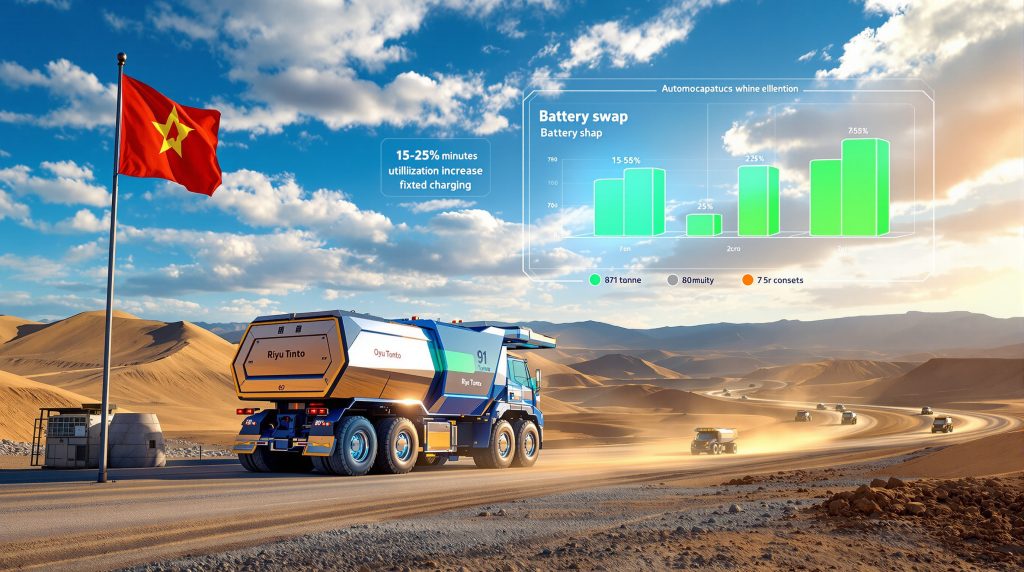Understanding Battery-Swap Technology and Its Revolutionary Mining Applications
Battery-swap technology represents a paradigm shift in electric vehicle infrastructure for heavy industrial applications. This innovative approach allows mining operators to replace depleted battery packs within minutes rather than waiting hours for conventional charging cycles. The battery-swap truck trial in Mongolia demonstrates how this technology can transform mining operations through rapid energy replenishment systems. The system utilises modular battery units that can be rapidly exchanged at dedicated stations, maintaining continuous operational capacity for electric haul trucks.
The core mechanism involves standardised battery interfaces and automated handling systems that can lift and replace 800kWh battery modules weighing several tonnes. This technology addresses the primary limitation of electric heavy equipment in mining operations: extended downtime during charging periods that can severely impact productivity in 24/7 mining environments.
Revolutionary Approach to Electric Mining Vehicle Infrastructure
Unlike traditional electric vehicle charging infrastructure, battery-swap systems eliminate the need for vehicles to remain stationary during energy replenishment. The technology employs robotic handling mechanisms and precision alignment systems to ensure safe, efficient battery exchanges in challenging mining environments characterised by dust, vibration, and temperature extremes.
The modular battery design incorporates advanced lithium-ion chemistry optimised for high-discharge applications typical in mining hauling operations. Each battery unit features integrated cooling systems, monitoring sensors, and safety protocols designed to withstand the demanding operational conditions of surface mining operations. Furthermore, this innovation supports broader mining industry innovation initiatives across the sector.
Strategic Partnership Framework and Mining Industry Decarbonisation Goals
The collaboration between Rio Tinto and China's State Power Investment Corporation (SPIC) Qiyuan represents a significant milestone in mining industry electrification efforts. This partnership leverages China's established battery-swap infrastructure experience, which has been successfully deployed in urban transportation networks, adapting it for the unique requirements of heavy mining equipment.
Rio Tinto's commitment to reducing Scope 1 and 2 carbon emissions has positioned haul truck electrification as a critical component of their decarbonisation strategy. Mining haulage operations typically contribute 30-40% of a mine's total carbon footprint, making electrification a high-impact intervention for emission reduction targets.
Strategic Partnership Framework Between Global Mining and Chinese Energy Innovation
The partnership structure combines Rio Tinto's operational expertise and global mining network with SPIC Qiyuan's battery-swap technology and manufacturing capabilities. This collaboration model enables rapid technology transfer and deployment, accelerating the timeline from concept to operational implementation compared to traditional in-house development approaches.
SPIC Qiyuan brings extensive experience from China's electric vehicle market, where battery-swap technology has achieved commercial viability in passenger vehicle and commercial transport sectors. The company's proven track record includes over 1,000 battery-swap stations deployed across major Chinese cities, demonstrating the scalability and reliability of the technology platform.
Operational Scope at Oyu Tolgoi Copper Mine Complex
The Oyu Tolgoi mine, located in Mongolia's South Gobi desert, provides an ideal testing environment for battery-swap technology due to its combination of challenging environmental conditions and significant hauling requirements. The mine's copper and gold operations require extensive topsoil movement and tailings dam construction, creating consistent demand for heavy hauling capacity.
Mongolia's regulatory framework has proven supportive of clean technology implementation, with government policies encouraging foreign investment in sustainable mining technologies. The country's strategic position between China and Russia, combined with its vast mineral resources, makes it an attractive location for testing innovative mining technologies that could be deployed across similar geographic and operational contexts.
Technical Specifications and Infrastructure Requirements
The battery-swap truck trial in Mongolia incorporates several key technical components designed to demonstrate commercial viability in real-world mining conditions. The system architecture emphasises modularity, reliability, and operational efficiency to meet the demanding requirements of continuous mining operations.
Fleet Composition and Vehicle Capabilities
| Component | Specification | Operational Impact |
|---|---|---|
| Electric Haul Trucks | 8 units at 91-tonne capacity | Suitable for medium-scale operations |
| Battery Units | 13 modular systems, 800kWh each | Extended operational range |
| Swap Station | Automated replacement facility | <7-minute battery exchange |
| Static Chargers | Dedicated charging infrastructure | Continuous power supply |
The Tonly electric haul trucks represent a significant advancement in electric mining vehicle design, incorporating specialised drivetrains optimised for the high-torque, low-speed requirements of mining operations. Each vehicle features regenerative braking systems that can recover up to 25% of energy during downhill operations, extending operational range and improving overall energy efficiency.
The 91-tonne payload capacity positions these vehicles in the small to medium-class category within Rio Tinto's global fleet classification system. This capacity range is particularly suitable for specialised applications such as tailings dam construction and topsoil transportation, where operational flexibility often takes precedence over maximum payload capacity.
Battery Exchange Process and Efficiency Metrics
"The seven-minute battery replacement process eliminates traditional charging downtime, potentially increasing equipment utilisation rates by 15-25% compared to conventional electric vehicle charging methods."
The battery exchange process utilises precision positioning systems and automated handling equipment to ensure consistent, safe operations across varying environmental conditions. The system incorporates multiple safety redundancies, including emergency stop mechanisms, load monitoring systems, and environmental sensors that can detect dust, moisture, or temperature conditions that might affect operation safety.
Each battery module weighs approximately 3.5 tonnes and requires specialised lifting equipment capable of precise positioning within tight tolerances. The exchange process includes automated electrical connection verification, thermal management system integration, and comprehensive diagnostic checks to ensure operational readiness before vehicle deployment. However, this technology forms part of larger energy transition strategies being implemented globally.
Mongolia as a Strategic Testing Ground for Mining Electrification
Mongolia's emergence as a preferred location for mining technology trials reflects several converging factors that make it an ideal environment for testing innovative heavy equipment solutions. The country's unique combination of challenging operating conditions, supportive regulatory framework, and strategic geographic position creates optimal conditions for technology validation.
Geographic and Logistical Advantages for Heavy Equipment Trials
The Gobi desert environment presents extreme temperature variations, dust conditions, and altitude challenges that closely replicate operating conditions found in major mining regions worldwide. Winter temperatures can reach -40°C while summer peaks exceed 40°C, providing comprehensive testing conditions for battery performance and thermal management systems.
Mongolia's proximity to China facilitates rapid deployment of technical support, replacement components, and specialised expertise required for advanced technology trials. This geographic advantage reduces logistical complexities and enables real-time technical support during the critical initial deployment phase. Additionally, this aligns with global initiatives for securing lithium supply chains.
Regulatory Environment Supporting Clean Technology Implementation
Mongolia's government has implemented progressive policies encouraging foreign investment in clean technology sectors, including streamlined approval processes for innovative mining equipment trials. The regulatory framework includes provisions for temporary equipment imports, expedited permitting for experimental infrastructure, and tax incentives for companies demonstrating environmental benefits.
The country's membership in regional trade agreements and bilateral investment treaties with both China and Australia creates a favourable legal environment for international technology partnerships. These frameworks provide intellectual property protections and dispute resolution mechanisms that encourage long-term technology development investments.
Operational Applications and Mining-Specific Use Cases
The battery-swap truck trial focuses on specific mining applications that can demonstrate the technology's capabilities while providing valuable operational data for future deployment decisions. These applications have been selected to showcase the technology's effectiveness in real-world mining scenarios whilst minimising operational risks during the trial period.
Tailings Dam Construction Requirements
Tailings dam construction represents one of the most critical applications for the battery-swap technology trial, as it requires consistent, reliable hauling capacity over extended periods. The construction process involves moving large volumes of specifically graded materials with strict quality control requirements, making equipment reliability paramount.
Electric haul trucks offer several advantages in tailings dam construction, including:
- Reduced noise pollution in sensitive areas
- Elimination of diesel exhaust emissions near water management systems
- Precise speed control for material placement accuracy
- Consistent torque delivery for challenging terrain navigation
- Real-time monitoring capabilities for load management
The battery-swap capability ensures that construction schedules can be maintained without interruption, as battery exchanges can be completed during routine material loading cycles without impacting overall productivity. This application demonstrates the potential for electric vehicles in mining operations.
Topsoil Transportation and Site Preparation Activities
Topsoil transportation operations require different operational characteristics compared to ore hauling, including lower-speed operations, frequent start-stop cycles, and operation in areas with limited infrastructure. These conditions provide an excellent testing environment for battery-swap technology capabilities in diverse operational scenarios.
The electric trucks' regenerative braking systems prove particularly beneficial in topsoil operations, which often involve navigating varied terrain with frequent elevation changes. The ability to recover energy during braking operations can extend operational range by 20-30% compared to conventional electric vehicles in similar applications.
Comparative Analysis: Battery-Swap vs. Traditional Mining Equipment
Understanding the performance characteristics and operational implications of battery-swap technology requires comprehensive comparison with both conventional diesel equipment and fixed-charging electric alternatives. This analysis provides critical insights into the technology's potential for widespread adoption in mining operations.
| Aspect | Battery-Swap Electric | Conventional Diesel | Fixed-Charging Electric |
|---|---|---|---|
| Refueling/Charging Time | <7 minutes | 5-10 minutes | 4-8 hours |
| Operational Flexibility | High | Very High | Limited |
| Emissions Profile | Zero direct emissions | High CO2/particulates | Zero direct emissions |
| Infrastructure Requirements | Moderate | Low | High |
| Maintenance Complexity | Moderate | High | Low |
| Energy Cost Variability | Low | High | Low |
| Cold Weather Performance | Good | Excellent | Poor |
| Remote Operation Capability | Good | Excellent | Limited |
The comparison reveals that battery-swap technology occupies a unique position in the electric mining vehicle spectrum, offering operational flexibility approaching that of conventional diesel equipment whilst maintaining the environmental benefits of full electrification.
Economic Analysis and Investment Implications
The economic viability of battery-swap technology in mining operations depends on multiple factors including initial capital investment, operational cost savings, and long-term maintenance requirements. Early analysis suggests that the technology may achieve cost parity with diesel alternatives within 3-5 years under favourable operating conditions.
Capital Investment Analysis for Battery-Swap Infrastructure
Initial infrastructure costs for battery-swap systems are estimated at $2-3 million per swap station, depending on capacity requirements and environmental hardening specifications. This investment includes:
- Automated battery handling equipment
- Static charging infrastructure for battery inventory
- Environmental protection systems
- Control and monitoring systems
- Site preparation and utility connections
The modular nature of the system allows for phased deployment, reducing initial capital requirements compared to comprehensive electrification approaches. Additional swap stations can be added as fleet sizes increase, providing scalability advantages for growing mining operations.
Operating Cost Projections Versus Diesel Alternatives
Preliminary economic modelling suggests potential operating cost savings of 30-40% compared to diesel alternatives, driven primarily by:
- Lower energy costs ($0.12-0.18 per kWh vs. $0.45-0.65 per diesel equivalent)
- Reduced maintenance requirements (50-60% fewer scheduled maintenance intervals)
- Elimination of diesel fuel price volatility
- Reduced environmental compliance costs
However, these savings must be weighed against battery replacement costs, which are projected at $150,000-200,000 per battery module over a 5-7 year operational lifespan. This economic model also benefits from recent battery recycling breakthrough technologies that reduce long-term costs.
Global Fleet Transformation Strategy and Scalability Assessment
Rio Tinto's global fleet transformation strategy positions the Mongolia trial as a critical proof-of-concept for potential deployment across their worldwide operations. The company's 700-truck global fleet represents a significant opportunity for carbon emission reduction and operational cost optimisation.
Scalability Assessment for 700-Truck Global Fleet
Analysis of Rio Tinto's global fleet composition reveals that approximately 100 vehicles fall within the small to medium-class category (100-200 tonne capacity), making them suitable candidates for current-generation battery-swap technology. This subset represents roughly 14% of the total fleet but accounts for approximately 25% of total fuel consumption due to their operational patterns.
Deployment across suitable fleet segments could potentially reduce Rio Tinto's total carbon emissions by 8-12%, contributing significantly to their 2030 carbon reduction targets. The modular deployment approach allows for risk management whilst building operational expertise and supply chain capabilities.
Integration Strategy for Small to Medium-Class Vehicles
The integration strategy focuses on operational segments where battery-swap technology offers the greatest advantages:
- Construction and development projects with predictable hauling patterns
- Environmental compliance applications requiring zero-emission operations
- Operations in regions with favourable electricity pricing and clean energy availability
- Sites with existing electrical infrastructure capable of supporting charging requirements
This targeted approach allows for technology maturation and cost optimisation before considering deployment in larger, higher-capacity vehicle categories.
Implementation Challenges and Technical Limitations
Despite the promising potential of battery-swap technology, several significant challenges must be addressed before widespread adoption in mining operations. These challenges range from technical limitations to supply chain considerations that could impact deployment timelines and cost projections.
Technical Limitations in Extreme Mining Environments
Mining operations often occur in environments that test equipment capabilities beyond typical industrial applications. Key technical challenges include:
- Battery performance degradation in extreme temperatures (-40°C to +50°C)
- Dust ingress protection for electrical components and connection systems
- Mechanical stress from vibration, shock loads, and continuous operation cycles
- Electromagnetic interference from mining equipment and blasting operations
Current battery technology experiences 15-25% capacity reduction in extreme cold conditions, requiring oversised battery systems or heating infrastructure that increases operational costs and complexity.
Supply Chain Considerations for Battery Production and Replacement
The global battery supply chain faces significant constraints that could impact large-scale deployment of battery-swap technology in mining applications. Critical considerations include:
- Lithium and rare earth mineral availability for large-scale battery production
- Manufacturing capacity limitations for specialised high-energy-density battery modules
- Geographic concentration of battery manufacturing in Asia, creating logistical challenges for global mining operations
- Recycling infrastructure development for end-of-life battery management
These supply chain factors could potentially limit deployment scalability and increase long-term operational costs if not adequately addressed through strategic partnerships and infrastructure development.
Alignment with Global Mining Decarbonisation Initiatives
The battery-swap truck trial in Mongolia represents one component of broader industry efforts to reduce carbon emissions and improve environmental performance across mining operations. This initiative aligns with emerging regulatory requirements and stakeholder expectations for sustainable mining practices.
Industry-Wide Emission Reduction Targets and Timelines
Major mining companies have established ambitious carbon reduction targets, with many committing to net-zero emissions by 2050. Intermediate targets typically include:
- 30-50% reduction in Scope 1 and 2 emissions by 2030
- 15% reduction in Scope 3 emissions through supply chain optimisation
- Implementation of renewable energy systems for 60-80% of operational power requirements
Haul truck electrification represents one of the highest-impact interventions available to mining companies, as mobile equipment typically accounts for 25-40% of total operational emissions.
Competitive Positioning Among Major Mining Companies
The Rio Tinto-SPIC Qiyuan partnership positions Rio Tinto as an early adopter of battery-swap technology, potentially providing competitive advantages in:
- ESG performance metrics valued by institutional investors
- Access to capital at preferential rates for sustainable technology deployment
- Regulatory compliance in jurisdictions implementing strict emission standards
- Operational cost advantages as technology matures and scales
Other major mining companies, including BHP, Vale, and Glencore, have announced similar electrification initiatives, creating a competitive dynamic that could accelerate technology adoption across the industry.
Success Metrics and Performance Evaluation Through 2026
The Mongolia trial's success will be measured against comprehensive performance metrics covering operational efficiency, cost effectiveness, and technical reliability. These metrics will inform decisions regarding broader technology deployment and investment levels.
Performance Metrics and Evaluation Criteria
Key performance indicators for the trial include:
Operational Metrics:
- Equipment availability rates (target: >95% compared to diesel baseline)
- Battery exchange cycle times (target: <7 minutes average)
- Payload utilisation efficiency (target: within 5% of diesel equivalent)
- Environmental condition adaptability (operation range: -30°C to +45°C)
Economic Metrics:
- Total cost of ownership comparison with diesel alternatives
- Energy efficiency measurements (kWh per tonne-kilometre)
- Infrastructure utilisation rates for swap stations and charging equipment
- Maintenance cost analysis and component reliability tracking
Technical Metrics:
- Battery degradation rates under mining operation conditions
- System integration reliability with existing mine infrastructure
- Safety incident tracking and risk assessment outcomes
Potential for Technology Transfer to Other Mining Sites
Successful demonstration in Mongolia could accelerate deployment across Rio Tinto's global operations and licensing opportunities with other mining companies. The transferability assessment will consider:
- Climate adaptability across different geographic regions
- Infrastructure requirements scalability for various mine sizes
- Regulatory compliance capabilities in different jurisdictions
- Supply chain optimisation for global deployment scenarios
The trial results will inform standardisation efforts that could reduce deployment costs and complexity for subsequent implementations. Furthermore, this technology demonstrates how Mongolia's mining sector is becoming a testbed for innovative solutions.
Long-term Implications for Mining Industry Sustainability
The successful development and deployment of battery-swap technology in mining operations could catalyse broader transformation across the industry, influencing equipment design, operational practices, and investment priorities for the next decade and beyond.
Investment Opportunities in Clean Mining Technology
The growing focus on mining industry decarbonisation is creating substantial investment opportunities across the technology value chain:
- Battery technology development and manufacturing capacity expansion
- Charging infrastructure and grid integration solutions
- Automation and control systems for electric mining equipment
- Renewable energy development for mining operations
Investment flows into clean mining technology reached $4.2 billion in 2024, representing a 35% increase from the previous year, indicating strong market confidence in the sector's growth potential.
Future Technology Integration Possibilities
Battery-swap technology could serve as a foundation for additional technological advancements in mining operations:
- Integration with autonomous vehicle systems for fully automated electric hauling
- Vehicle-to-grid capabilities for mine power system stabilisation
- Advanced predictive maintenance systems leveraging battery performance data
- Integration with renewable energy systems for sustainable power supply
These technological convergence opportunities could multiply the operational and environmental benefits of electrification initiatives whilst creating additional economic value for mining companies investing in clean technology solutions. The battery-swap truck trial in Mongolia thus represents a crucial milestone in the transformation of mining industry practices.
Disclaimer: This analysis is based on publicly available information and industry projections. Actual performance, costs, and deployment timelines may vary significantly based on technological developments, market conditions, and operational factors. Investment decisions should be based on comprehensive due diligence and professional financial advice.
Looking to Invest in Mining's Clean Technology Revolution?
Discovery Alert's proprietary Discovery IQ model delivers real-time notifications on significant ASX mineral discoveries, including breakthrough clean technology developments transforming the mining sector. Subscribers gain immediate access to actionable insights on companies pioneering battery technology, electrification solutions, and sustainable mining innovations before these opportunities reach mainstream attention. Begin your 30-day free trial today to position yourself at the forefront of mining's technological transformation.




